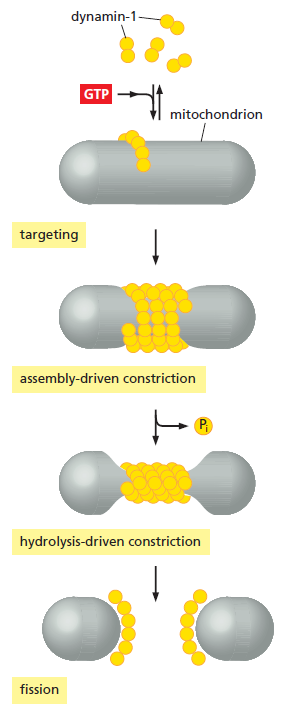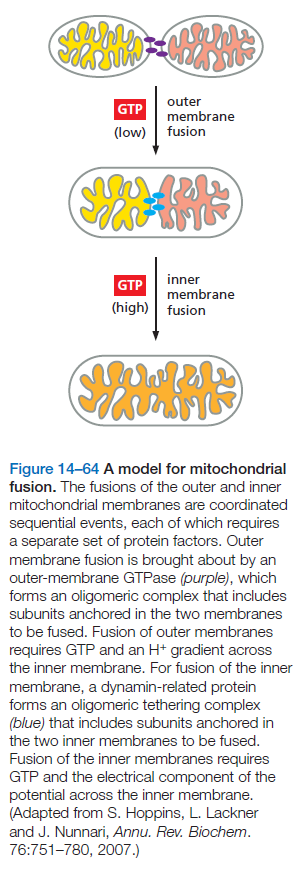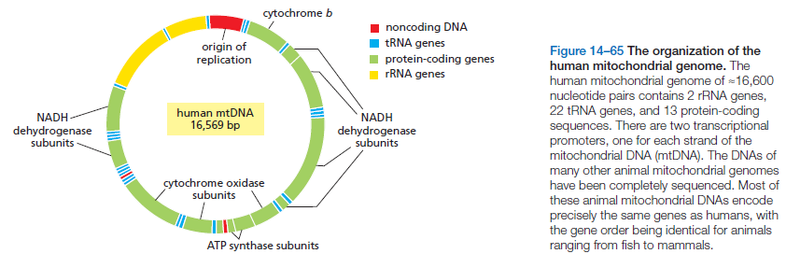The Fission and Fusion of Mitochondria 1
https://reasonandscience.catsboard.com/t2368-the-fission-and-fusion-of-mitochondria
In mammalian cells, mitochondrial DNA makes up less than 1% of the total cellular DNA. In other cells, however, such as the leaves of higher plants or the very large egg cells of amphibians, a much larger fraction of the cellular DNA may be present in mitochondria or chloroplasts, and a large fraction of the total RNA and protein synthesis takes place in the organelles. Mitochondria and chloroplasts are large enough to be visible by light microscopy in living cells. For example, mitochondria can be visualized by expressing in cells a genetically engineered fusion of a mitochondrial protein linked to green fluorescent protein (GFP), or cells can be incubated with a fluorescent dye that is specifically taken up by mitochondria because of their membrane potential. Such images demonstrate that the mitochondria in living cells are dynamic—frequently dividing by fission, fusing, and changing shape. The fission of mitochondria may be necessary so that small parts of the network can pinch off and reach remote regions of the cell—for example in the thin, extended axon and dendrites of a neuron. The fission and fusion of mitochondria are topologically complex processes that must ensure the integrity of the separate mitochondrial compartments defined by the inner and outer membranes. These processes control the number and shape of mitochondria, which can vary dramatically in different cell types, ranging from multiple spherical or wormlike organelles to a highly branched, net-shaped single organelle called a reticulum. Each depends on its own special set of proteins. The mitochondrial fission machine works by assembling dynamin-related GTPases into helical oligomers that cause local constrictions in tubular mitochondria. GTP hydrolysis then generates the mechanical force that severs the inner and outer mitochondrial membranes in one step (Figure 14–63).

Figure 14–63 A model for mitochondrial division. Dynamin-1 (yellow) exists as dimers in the cytosol, which form larger oligomeric structures in a process that requires GTP hydrolysis. Dynamin assemblies interact with the
outer mitochondrial membrane through special adaptor proteins, forming a spiral of GTP-dynamin around the mitochondrion that causes a constriction. A concerted GTP-hydrolysis event in the dynamin subunits is then thought to produce the conformational changes that result in fission.
Mitochondrial fusion requires two separate machineries, one each for the outer and the inner membrane (Figure 14–64)

In addition to GTP hydrolysis for force generation, both mechanisms also depend on the mitochondrial proton-motive force for reasons that are still unknown.
Animal Mitochondria Contain the Simplest Genetic Systems Known
Comparisons of DNA sequences in different organisms reveal that, in vertebrates (including ourselves), the mutation rate during evolution has been roughly 100 times greater in the mitochondrial genome than in the nuclear genome. This difference is likely to be due to lower fidelity of mitochondrial DNA replication, inefficient DNA repair, or both, given that the mechanisms that perform these processes in the organelle are relatively simple compared with those in the nucleus. As discussed in Chapter 4, the relatively high rate of evolution of animal mitochondrial genes makes a comparison of mitochondrial DNA sequences especially useful for estimating the dates of relatively recent evolutionary events, such as the steps in primate evolution. There are 13 protein-encoding genes in human mitochondrial DNA (Figure 14–65).

These code for hydrophobic components of the respiratory-chain complexes and of ATP synthase. In contrast, roughly 1000 mitochondrial proteins are encoded in the nucleus, produced on cytosolic ribosomes, and imported by the protein import machinery in the outer and inner membrane . It has been suggested that the cytosolic production of hydrophobic membrane proteins and their import into the organelle may present a problem to the cell, and that this is the reason why their genes have remained in the mitochondrion. However, some of the most hydrophobic mitochondrial proteins, such as the c subunit of the ATP synthase rotor ring, are imported from the cytosol in some species (though they are mitochondrially encoded in others). And the parasites Plasmodium falciparum and Leishmania tarentolae, which spend most of their life cycles inside cells of their host organisms, have retained only two or three mitochondrially encoded proteins. The size range of mitochondrial DNAs is similar to that of viral DNAs. The mitochondrial DNA in Plasmodium falciparum (the human malaria parasite) has less than 6000 nucleotide pairs, whereas the mitochondrial DNAs of some land plants contain more than 300,000 nucleotide pairs (Figure 14–66). In animals, the mitochondrial genome is a simple DNA circle of about 16,600 nucleotide pairs (less than 0.001% of the nuclear genome), and it is nearly the same size in organisms as different from us as Drosophila and sea urchins.
Conformational changes in Dnm1 support a contractile mechanism for mitochondrial fission
http://www.nature.com.sci-hub.cc/nsmb/journal/v18/n1/full/nsmb.1949.html
https://reasonandscience.catsboard.com/t2368-the-fission-and-fusion-of-mitochondria
In mammalian cells, mitochondrial DNA makes up less than 1% of the total cellular DNA. In other cells, however, such as the leaves of higher plants or the very large egg cells of amphibians, a much larger fraction of the cellular DNA may be present in mitochondria or chloroplasts, and a large fraction of the total RNA and protein synthesis takes place in the organelles. Mitochondria and chloroplasts are large enough to be visible by light microscopy in living cells. For example, mitochondria can be visualized by expressing in cells a genetically engineered fusion of a mitochondrial protein linked to green fluorescent protein (GFP), or cells can be incubated with a fluorescent dye that is specifically taken up by mitochondria because of their membrane potential. Such images demonstrate that the mitochondria in living cells are dynamic—frequently dividing by fission, fusing, and changing shape. The fission of mitochondria may be necessary so that small parts of the network can pinch off and reach remote regions of the cell—for example in the thin, extended axon and dendrites of a neuron. The fission and fusion of mitochondria are topologically complex processes that must ensure the integrity of the separate mitochondrial compartments defined by the inner and outer membranes. These processes control the number and shape of mitochondria, which can vary dramatically in different cell types, ranging from multiple spherical or wormlike organelles to a highly branched, net-shaped single organelle called a reticulum. Each depends on its own special set of proteins. The mitochondrial fission machine works by assembling dynamin-related GTPases into helical oligomers that cause local constrictions in tubular mitochondria. GTP hydrolysis then generates the mechanical force that severs the inner and outer mitochondrial membranes in one step (Figure 14–63).

Figure 14–63 A model for mitochondrial division. Dynamin-1 (yellow) exists as dimers in the cytosol, which form larger oligomeric structures in a process that requires GTP hydrolysis. Dynamin assemblies interact with the
outer mitochondrial membrane through special adaptor proteins, forming a spiral of GTP-dynamin around the mitochondrion that causes a constriction. A concerted GTP-hydrolysis event in the dynamin subunits is then thought to produce the conformational changes that result in fission.
Mitochondrial fusion requires two separate machineries, one each for the outer and the inner membrane (Figure 14–64)

In addition to GTP hydrolysis for force generation, both mechanisms also depend on the mitochondrial proton-motive force for reasons that are still unknown.
Animal Mitochondria Contain the Simplest Genetic Systems Known
Comparisons of DNA sequences in different organisms reveal that, in vertebrates (including ourselves), the mutation rate during evolution has been roughly 100 times greater in the mitochondrial genome than in the nuclear genome. This difference is likely to be due to lower fidelity of mitochondrial DNA replication, inefficient DNA repair, or both, given that the mechanisms that perform these processes in the organelle are relatively simple compared with those in the nucleus. As discussed in Chapter 4, the relatively high rate of evolution of animal mitochondrial genes makes a comparison of mitochondrial DNA sequences especially useful for estimating the dates of relatively recent evolutionary events, such as the steps in primate evolution. There are 13 protein-encoding genes in human mitochondrial DNA (Figure 14–65).

These code for hydrophobic components of the respiratory-chain complexes and of ATP synthase. In contrast, roughly 1000 mitochondrial proteins are encoded in the nucleus, produced on cytosolic ribosomes, and imported by the protein import machinery in the outer and inner membrane . It has been suggested that the cytosolic production of hydrophobic membrane proteins and their import into the organelle may present a problem to the cell, and that this is the reason why their genes have remained in the mitochondrion. However, some of the most hydrophobic mitochondrial proteins, such as the c subunit of the ATP synthase rotor ring, are imported from the cytosol in some species (though they are mitochondrially encoded in others). And the parasites Plasmodium falciparum and Leishmania tarentolae, which spend most of their life cycles inside cells of their host organisms, have retained only two or three mitochondrially encoded proteins. The size range of mitochondrial DNAs is similar to that of viral DNAs. The mitochondrial DNA in Plasmodium falciparum (the human malaria parasite) has less than 6000 nucleotide pairs, whereas the mitochondrial DNAs of some land plants contain more than 300,000 nucleotide pairs (Figure 14–66). In animals, the mitochondrial genome is a simple DNA circle of about 16,600 nucleotide pairs (less than 0.001% of the nuclear genome), and it is nearly the same size in organisms as different from us as Drosophila and sea urchins.
Conformational changes in Dnm1 support a contractile mechanism for mitochondrial fission
http://www.nature.com.sci-hub.cc/nsmb/journal/v18/n1/full/nsmb.1949.html

